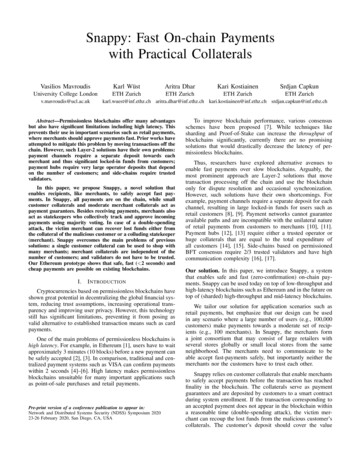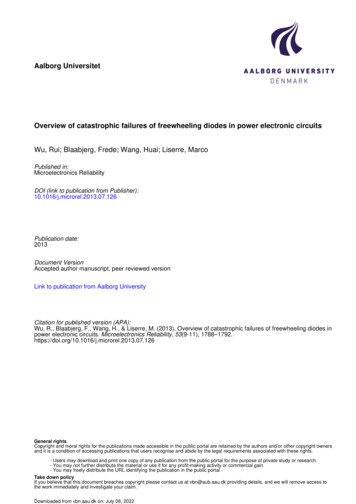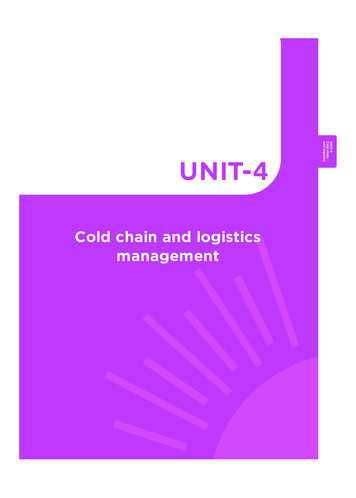
Transcription
Snappy: Fast On-chain Paymentswith Practical CollateralsVasilios MavroudisUniversity College Londonv.mavroudis@ucl.ac.ukKarl WüstAritra DharKari KostiainenSrdjan CapkunETH ZurichETH ZurichETH ZurichETH Zurichkarl.wuest@inf.ethz.ch aritra.dhar@inf.ethz.ch kari.kostiainen@inf.ethz.ch srdjan.capkun@inf.ethz.chAbstract—Permissionless blockchains offer many advantagesbut also have significant limitations including high latency. Thisprevents their use in important scenarios such as retail payments,where merchants should approve payments fast. Prior works haveattempted to mitigate this problem by moving transactions off thechain. However, such Layer-2 solutions have their own problems:payment channels require a separate deposit towards eachmerchant and thus significant locked-in funds from customers;payment hubs require very large operator deposits that dependon the number of customers; and side-chains require trustedvalidators.In this paper, we propose Snappy, a novel solution thatenables recipients, like merchants, to safely accept fast payments. In Snappy, all payments are on the chain, while smallcustomer collaterals and moderate merchant collaterals act aspayment guarantees. Besides receiving payments, merchants alsoact as statekeepers who collectively track and approve incomingpayments using majority voting. In case of a double-spendingattack, the victim merchant can recover lost funds either fromthe collateral of the malicious customer or a colluding statekeeper(merchant). Snappy overcomes the main problems of previoussolutions: a single customer collateral can be used to shop withmany merchants; merchant collaterals are independent of thenumber of customers; and validators do not have to be trusted.Our Ethereum prototype shows that safe, fast ( 2 seconds) andcheap payments are possible on existing blockchains.I.I NTRODUCTIONCryptocurrencies based on permissionless blockchains haveshown great potential in decentralizing the global financial system, reducing trust assumptions, increasing operational transparency and improving user privacy. However, this technologystill has significant limitations, preventing it from posing asvalid alternative to established transaction means such as cardpayments.One of the main problems of permissionless blockchains ishigh latency. For example, in Ethereum [1], users have to waitapproximately 3 minutes (10 blocks) before a new payment canbe safely accepted [2], [3]. In comparison, traditional and centralized payment systems such as VISA can confirm paymentswithin 2 seconds [4]–[6]. High latency makes permissionlessblockchains unsuitable for many important applications suchas point-of-sale purchases and retail payments.Pre-print version of a conference publication to appear in:Network and Distributed Systems Security (NDSS) Symposium 202023-26 February 2020, San Diego, CA, USATo improve blockchain performance, various consensusschemes have been proposed [7]. While techniques likesharding and Proof-of-Stake can increase the throughput ofblockchains significantly, currently there are no promisingsolutions that would drastically decrease the latency of permissionless blockchains.Thus, researchers have explored alternative avenues toenable fast payments over slow blockchains. Arguably, themost prominent approach are Layer-2 solutions that movetransaction processing off the chain and use the blockchainonly for dispute resolution and occasional synchronization.However, such solutions have their own shortcomings. Forexample, payment channels require a separate deposit for eachchannel, resulting in large locked-in funds for users such asretail customers [8], [9]. Payment networks cannot guaranteeavailable paths and are incompatible with the unilateral natureof retail payments from customers to merchants [10], [11].Payment hubs [12], [13] require either a trusted operator orhuge collaterals that are equal to the total expenditure ofall customers [14], [15]. Side-chains based on permissionedBFT consensus require 2/3 trusted validators and have highcommunication complexity [16], [17].Our solution. In this paper, we introduce Snappy, a systemthat enables safe and fast (zero-confirmation) on-chain payments. Snappy can be used today on top of low-throughput andhigh-latency blockchains such as Ethereum and in the future ontop of (sharded) high-throughput and mid-latency blockchains.We tailor our solution for application scenarios such asretail payments, but emphasize that our design can be usedin any scenario where a large number of users (e.g., 100,000customers) make payments towards a moderate set of recipients (e.g., 100 merchants). In Snappy, the merchants forma joint consortium that may consist of large retailers withseveral stores globally or small local stores from the sameneighborhood. The merchants need to communicate to beable accept fast-payments safely, but importantly neither themerchants nor the customers have to trust each other.Snappy relies on customer collaterals that enable merchantsto safely accept payments before the transaction has reachedfinality in the blockchain. The collaterals serve as paymentguarantees and are deposited by customers to a smart contractduring system enrollment. If the transaction corresponding toan accepted payment does not appear in the blockchain withina reasonable time (double-spending attack), the victim merchant can recoup the lost funds from the malicious customer’scollaterals. The customer’s deposit should cover the value
moderately-sized and reusable collaterals that are practical for both customers and merchants.v Security proof. We prove that merchants are guaranteedto receive the full value of all accepted payments, in anypossible combination of double spending by maliciouscustomers and equivocation by colluding statekeepers.v Evaluation. We implemented Snappy on Ethereum andshow that payment processing is fast and cheap in practice.of the customer’s purchases within the latency period of theblockchain (e.g., 3 minutes in Ethereum) which makes themsmall in practice (e.g., 100 would suffice for many users).Moreover, customers do not need to repeatedly replenish theircollaterals, as they are used only in the case of attack.In Snappy, the payment recipients (merchants) act asuntrusted statekeepers whose task is to track and collectivelyapprove incoming transactions. To initiate a fast payment,a customer creates a transaction that transfers funds to asmart contract and indicates the merchant as beneficiary. Therecipient merchant sends the transaction to the statekeepers andproceeds with the sale only if a majority of them approves itwith their signatures. Upon collecting the required signatures,the merchant broadcasts the transaction in the blockchainnetwork to be processed by an Arbiter smart contract. Oncethe transaction is processed and logged by the Arbiter, thepayment value is forwarded to the merchant.This paper is organized as follows: Section II explains theproblem of fast payments, Section III provides an overview ofour solution and Section IV describes it in detail. Section Vprovides security analysis and Section VI further evaluation.Section VII is discussion, Section VIII describes related work,and Section IX concludes the paper.II.Statekeepers must also deposit collaterals that protect merchants from attacks where a malicious statekeeper colludeswith a customer. In such a case, the victim merchant can usethe statekeeper’s approval signatures as evidence to claim anylost funds from the misbehaving statekeeper’s collateral. Thesize of statekeeper collateral is proportional to the total amountof purchases that all participating merchants expect within theblockchain latency period. Crucially, the statekeeper collateralsare independent of the number of customers which allowsthe system to scale. The main security benefit of statekeepercollaterals is that they enable fast and safe payments withouttrusted parties.P ROBLEM S TATEMENTIn this section we motivate our work, explain our assumptions, discuss the limitations of previous solutions, and specifyrequirements for our system.A. MotivationThe currently popular permissionless blockchains (e.g., Bitcoin and Ethereum) rely on Proof-of-Work (PoW) consensusthat has well-known limitations, including low throughput (7transactions per second in Bitcoin), high latency (3 minutesin Ethereum), and excessive energy consumption (comparableto a small country [18]). Consequently, the research community has actively explored alternative permissionless consensus schemes. From many proposed schemes, two prominentapproaches, Proof of Stake and sharding, stand out [7].Main results. We prove that a merchant who follows theSnappy protocol and accepts a fast payment once it has beenapproved by the majority of the statekeepers never loses fundsregardless of any combination of customer and statekeepercollusion. We also demonstrate that Snappy is practical todeploy on top of existing blockchains by implementing iton Ethereum. The performance of our solution depends primarily on number of participating statekeepers (merchants).For example, assuming a deployment with 100 statekeepers, apayment can be approved in less than 200 ms with a processingcost of 0.16 (169k Ethereum gas), which compares favorablyto card payment fees.Proof of Stake (PoS) systems aim to minimize the energy waste by replacing the computationally-heavy puzzlesof PoW with random leader election such that the leaderselection probability is proportional to owned staked. While thecurrent PoS proposals face various security and performanceissues [7], the concept has shown promise in mitigating theenergy-consumption problem.Sharding systems increase the blockchain’s throughput bydividing the consensus participants into committees (shards)that process distinct sets of transactions. Recent results reported significant throughput increases in the order of thousands of transactions per second [19], [20]. Despite severalremaining challenges, sharding shows great promise in improving blockchain throughput.Snappy overcomes the main problems of Layer-2 solutionsin application scenarios such as retail payments. In contrastto BFT side-chains that assume that 2/3 honest validators andrequire multiple rounds of communication, Snappy requires notrusted validators and needs only one round of communication.Unlike payment channels, Snappy enables payments towardsmany merchants with a single and small customer deposit. Incontrast to payment networks, Snappy payments can alwaysreach the merchants, because there is no route depletion. Andfinally, the statekeeping collaterals are practical even for largerdeployments, compared to those in payment hubs, as they areindependent of the number of customers in the system.Sharding and PoS can also address transaction latency.Recent works such as Omniledger [19] and RapidChain [20]use both techniques and report latencies from 9 to 63 seconds,assuming common trust models like honest majority or 1/3Byzantine nodes. However, such measurements are achievedin fast test networks (permissionless blockchains rely on slowpeer-to-peer networks) and under favorable work loads (e.g.,largely pre-sharded transactions).Contributions. This paper makes the following contributions:Our conclusion is that while permissionless blockchainthroughput and energy efficiency are expected to improve inthe near future, latency will most likely remain too high forvarious scenarios such as point-of-sale payments and retailv Novel solution for fast payments. We propose a system called Snappy that enables fast and secure payments on slow blockchains without trusted parties using2
Payment channels transfer funds between two parties. The security of such solutions is guaranteed by separate deposits thatmust cover periodic expenditure in each individual channel. Inour “small shops” example with k 100 merchants and anaverage customer expenditure of e 10, the customers wouldneed to deposit combined 1,000. In our “large retailers”example with k 100 merchants and expenditure of e 250,the total deposit is 25,000. Payment channels require periodicdeposit replenishment.shopping, where payment confirmation is needed within 12 seconds. Therefore, in this paper we focus on improvingblockchain payment latency. We consider related problems likelimited blockchain throughput as orthogonal problems withknown solutions. Appendix A provides further background onpermissionless consensus.B. System Model and AssumptionsCustomers and merchants. We focus on a setting where nusers send payments to k recipients such that n is large andk is moderate. One example scenario is a set of k 100small shops where n 100, 000 customers purchase goods at.Another example is k 100 larger retail stores with n 1million customers [21], [22].Payment networks address the above problem of having toset up many separate channels by using existing paymentchannels to find paths and route funds. Payments are possibleonly when the necessary links from the source (customer) tothe destination (merchant) exist. However, payment networksare unreliable, as guaranteeing the suitable links between allparties is proven difficult [28]. Moreover, retail payments arepre-dominantly one-way from customers to merchants, andthus those links get frequently depleted, reducing the routeavailability even further [29].We consider merchants who accept no risk, i.e., they handthe purchased products or services to the customers, only ifthey are guaranteed to receive the full value of their sale.Therefore, naive solutions such as accepting zero-confirmationtransaction are not applicable [23]. The customers are assumedto register once to the system (similar to a credit card issuanceprocesses) and then visit shops multiple times.Payment hubs attempt to solve the route-availability problemby having all customers establish a payment channel to acentral hub that is linked to all merchants. The main problem ofthis approach is that the hub operator either has to be trusted orit needs to place a very large deposit to guarantee all payments.Since the required collateral is proportional to the number ofcustomers, in our large retailers example, a hub operator willhave to deposit 250M to support n 1M customers withan expenditure of e 250. To cover the cost of locking insuch a large mount of funds, the operator is likely to chargesubstantial payment fees.We assume that merchants have permanent and fairlyreliable Internet connections. Customers are not expected to beonline constantly or periodically (initial online registration issufficient). At the time of shopping, customers and merchantscan communicate over the Internet or using a local channel,such as a smartphone NFC or smart card APDU interface.Blockchain. We assume a permissionless blockchain that hassufficient throughput, but high latency (see motivation). Theblockchain supports smart contracts. We use Ethereum as a reference platform throughout this work, but emphasize that oursolution is compatible with most permissionless blockchainswith smart contracts [24]–[26]. To ensure compatibility withexisting systems like Ethereum, we assume that smart contractshave access to the current state of the blockchain, but not toall the past transactions.Commit-chains aim to improve payment hubs by reducingor eliminating operator collaterals. To do that, they rely onperiodic on-chain checkpoints that finalize multiple off-chaintransactions at once. While this improves throughput, it doesnot reduce latency, as users still have to wait for the checkpointto reach finality on-chain [14], [30]. Other commit-chainvariants enable instant payments, but require equally largecollaterals as payment hubs. Additionally, in such variantsusers need to monitor the checkpoints (hourly or daily) toensure that their balance is represented accurately [14], [31].We focus on retail setting where customers do not have to beconstantly or periodically online (recall Section II-B), and thuscannot be expected to perform such monitoring.Adversary. The main goal of this paper is to enable secureand fast payments. Regarding payment security, we considera strong adversary who controls an arbitrary number of customers and all other merchants besides the target merchant whoaccepts a fast payment. The adversary also controls the network connections between customers and merchants but cannotlaunch network-level attacks such as node eclipsing [27].The adversary cannot violate the consensus guarantees ofthe blockchain, prevent smart contract execution, or violatecontract integrity.Side-chains rely on a small number of collectively trustedvalidators to track and agree on pending transactions. Typically, consensus is achieved using Byzantine-fault tolerantprotocols [32] that scale up to a few tens of validators andrequire 2/3 of honest validators. Thus, side-chains contradictone of the main benefits of permissionless blockchains, thefact that no trusted entities are required. Additionally, BFTconsensus requires several communication rounds and has highmessage complexity.For payment liveness, we additionally require that sufficiently many merchants are responsive (see Section V-B).C. Limitations of Known SolutionsA prominent approach to enable fast payments on slowpermissionless blockchains is so called Layer-2 solutionsthat move transaction processing off the chain and use theblockchain only in case of dispute resolution and occasionalsynchronization between the on-chain and off-chain states.Here, we outline the main limitations of such solutions.Section VIII provides more details on Layer-2 solutions andtheir limitations.D. RequirementsGiven these limitations of previous solution, we define thefollowing requirements for our work.3
v R1: Fast payments without trusted validators. Our solution should enable payment recipients such as merchantsto accept fast payments assuming no trusted validators.v R2: Practical collaterals for large deployments. Collaterals should be pratical, even when the system scalesfor large number of customers or many merchants. Inparticular, the customer collaterals should only dependon their own spending, not the number of merchants.The entities that operate the system (in our solution, themerchants) should deposit an amount that is proportionalto their sales, not the number of customers.v R3: Cheap payment processing. When deployed on top ofan existing blockchain system such as Ethereum, paymentprocessing should be inexpensive.III.Unanimous approval. Alternatively, merchants could sendeach incoming transaction to all other merchants and waituntil each of them responds with a signed approval. Whilesome of the merchants may act maliciously and equivocate,rational merchants holding pending transactions from the samecustomer will not, as this would put their own payments at risk.The Arbiter contract would refuse to process any claims forlosses, unless the merchant can provide approval statementsfrom all other merchants. Such unanimous approval preventsthe previous attack (assuming rational actors), but it suffersfrom poor liveness. Even if just one of the merchants isunreachable, the system cannot process payments.BFT consensus. A common way to address such availabilityconcerns is to use Byzantine-fault tolerant protocols. Forexample, the merchants could use a BFT consensus suchas [32] to stay up to date with all the pending payments. Sucha solution can tolerate up to 1/3 faulty (e.g., non-responsive)merchants and thus provides increased availability comparedto the previous design. However, this solution has all thelimitations of side-chains (recall Section II-C). In particular,BFT consensus requires 2/3 trusted validators and severalrounds of communication. Therefore, BFT side-chains are notideal even in the case of mutually-trusting merchants.S NAPPY OVERVIEWIn our solution, Snappy, customer collaterals are held by asmart contract called Arbiter and enable merchants to safelyaccept payments before a transaction reaches finality on thechain. If a pending transaction does not get confirmed onthe chain (double spending attack), the victim merchant canrecover the lost funds from the customer’s collateral.For any such solution, it is crucial that the total value of acustomer’s pending transactions never exceeds the value of itscollateral. This invariant is easy to ensure in a single-merchantsetup by keeping track of the customers’ pending transactions.However, in a retail setting with many merchants, each individual merchant does not have a complete view of each customer’spending payments, as each customer can perform purchaseswith several different merchants simultaneously.B. Snappy Main ConceptsTo overcome the problems of the above strawman designs,we use two primary techniques: (a) majority approval and (b)merchant collaterals, such that fast payments can be acceptedsafely even if all the merchants are untrusted and some of themare unreachable.The use of majority approval generates non-deniable evidence about potentially misbehaving merchants. Together withmerchant collaterals, this enables attack victims to recover theirlosses, in case a merchant colludes with a malicious customer.In an example attack, a malicious customer sends transactionτ to a victim merchant and τ 0 to a colluding merchant, andsimultaneously double spends both τ and τ 0 . The colludingmerchant claims the lost value from the customer’s collateralwhich exhausts it and prevents the victim merchant fromrecovering losses from the customer’s collateral. However, thevictim can use the colluding merchant’s signature from themajority approval process as evidence and reclaim the lostfunds from the merchant’s collateral. Given these main ideas,next we provide a brief overview of how Snappy works.A natural approach to address this problem is to assumethat the merchants collaborate and collectively track pendingtransactions from all customers (see Figure 2 (right)). Below,we outline simple approaches to realize such collaboration andpoint out their drawbacks that motivate our solution.A. Strawman DesignsTransaction broadcasting. Perhaps the simplest approachwould be to require that all merchants broadcast all incomingpayments, so that everyone can keep track of the pending transactions from each customer. Such a solution would preventcustomers from exceeding their collateral’s value, but assumesthat all the merchants are honest. A malicious merchant,colluding with a customer, could mislead others by simplynot reporting some of the customer’s pending payments. Thecustomer can then double spend on all of its pending transactions, thus enabling the colluding merchant to deplete itscollateral and prevent other merchants from recovering theirlosses. The same problem would arise also in cases wherea benign merchant fails to communicate with some of themerchants (e.g., due to a temporary network issue) or if theadversary drops packets sent between merchants.Collaterals. To register in the Snappy system, each customerdeposits a collateral to Arbiter’s account (see “Registration”in Figure 1 (left)). The value of the collateral is determinedby the customer, and it should suffice to cover its expenditureet during the blockchain latency period (e.g., et 100 for 3minutes in Ethereum).Since merchants are untrusted, they also need to deposita collateral. The size of the merchant collateral depends onthe total value of sales that all participating merchants processwithin the latency period. For example, for a consortium ofk 100 small shops that process pt 6 payments of et 5on average during the latency period, a collateral of 3,000will suffice. In a deployment with k 100 larger retailers,where each one handles pt 15 purchases of et 100 (onaverage) within the latency period, each merchant will needWe argue that such transaction broadcasting might be applicable in specific settings (e.g., large retailers that trust eachother and are connected via high-availability links), but it failsto protect mutually-distrusting merchants such as small shopsor restaurants, and is unsuited to scenarios where mutuallytrusting merchants cannot establish expensive links.4
visibility to past transactions for contracts, payments can bealso routed directly from the customers to the merchants.Settlements. If the transaction does not appear in theblockchain after a reasonable delay (i.e., double-spendingattack took place), the victim merchant can initiate a settlementprocess with the arbiter to recover the lost funds (“Attack inFigure 1 (left)). The Arbiter uses the logged approval evidencefrom its state to determine who is responsible for the attack,and it returns the lost funds to the victim merchant either fromthe collateral of the customer or the misbehaving merchantwho issued false approval.Separation of statekeeping. So far, we have assumed thatpayment approval requires signatures from merchants whotrack pending transactions. While we anticipate this to be themost common deployment option, for generality and separationof duties, we decouple the tracking and approval task ofmerchants into a separate role that we call statekeeper. For therest of the paper, we assume a one-to-one mapping betweenmerchants and statekeepers, as shown in Figure 2 (right) and inAppendix B we discuss alternative deployment options. Whenthere are an identical number of merchants and statekeepers,the value of statekeepers’ collaterals is determined as alreadyexplained for merchant collaterals.Fig. 1 (left): Flow of funds. Customers and merchants depositcollaterals to the arbiter smart contract. Payments flow from customersto merchants through the arbiter. In case of attack, the victim merchantcan recover any losses from the arbiter.Fig. 2 (right): Example deployment where each merchant operatesone statekeeper. Customers make payments towards merchants, whoconsult a majority of the statekeepers before accepting them.to deposit 150,000 [21], [22]. We acknowledge that this is asignificant deposit, but feasible for large corporations.Incentives. There are multiple reasons why merchants wouldwant to act as statekeepers. One example reason is that it allows them to join a Snappy consortium, accept fast blockchainpayments securely and save on card payment fees. To put thepotential saving into perspective, considering our large retailstores example and the common 1.5% card payment fee (and acost of 0.16 per Snappy payment). In such a case, a collateralof 150,000 is amortized in 37 days. Potential free-ridingby a consortium member could be handled by maintaining aratio of approvals made and received for each merchant andexcluding merchants who fall below a threshold.Payment approval. After registering, a customer can initiatea payment by sending a payment intent to a merchant togetherwith a list of its previous approved but not yet finalizedtransactions. The merchant can verify that the provided listis complete, by examining index values that are part of eachSnappy transaction. If the total value of intended payment andthe previously approved payments does not exceed the valueof the customer’s collateral, the merchant proceeds.To protect itself against conflicting Snappy transactionssent to other merchants simultaneous, the merchant collectsapproval signatures from more than half of the participating merchants, as shown in Figure 2 (right). Such majorityapproval does not prevent malicious merchants from falselyaccepting payments, but provides undeniable evidence of suchmisbehavior that the merchant can later use to recover lossesin case of an attack. In essence, a merchant m signing atransaction τ attests that “m has not approved other transactions from the same customer that would conflict with τ”.Thus, m needs to check each transaction against those it hassigned in the past. The merchant who is about to accept apayment also verifies that the approving merchants have eachsufficient collateral left in the system to cover the approvedpayment. Once these checks are complete, the merchant cansafely accept the payment.Another example reason is that the merchants could establish a fee-based system where each approver receives a smallpercentage of the transaction’s value to cover the operationalcost and the collateral investment needed to act as a statekeeper.IV.S NAPPY D ETAILSIn this section, we describe the Snappy system in detail. Weinstantiate it for Ethereum, but emphasize that our solutionis not limited to this particular blockchain. We start withbackground on aggregate signatures, followed by Snappy datastructures, registration, payment and settlement protocols.The customer construct a complete Snappy payment suchthat the payment funds are initially sent to Arbiter that logsthe approval details into its state and after that forwards thepayment value to the receiving merchant (see “Payment” inFigure 1 (left)). We route all payments through the Arbitercontract to enable the Arbiter to perform claim settlement inblockchain systems like Ethereum where smart contracts donot have perfect visibility to all past transactions (recall Section II-B). If future blockchain systems offer better transactionA. Background on BLS SignaturesTo enable signature aggregation for reduced transaction sizeand efficient transaction verification, we utilize the BonehLynn-Shacham (BLS) Signature Scheme [33], along withextensions from [34], [35]. BLS signatures are built on topof a bilinear group and a cryptographic hash function H :5
FieldToFromValueECDSA Sig.Data, , , , , OperationMerchantPayment bolDescriptionτtoτfτvv, r, s160-bit160-bitInteger256-bitsArbiters addrCustomer’s addrTransferred fundsTx signature ts256-bitse.g., “Pay”, “Claim”Merchant’s addressMonotonic counterAggregate signatureApproving partiesCustomers, entry, Collateral, Clearance, Finalized, entry, Hash, Signatures, Quoru
Snappy overcomes the main problems of Layer-2 solutions in application scenarios such as retail payments. In contrast to BFT side-chains that assume that 2 3 honest validators and require multiple rounds of communication, Snappy requires no trusted validators and needs only one round of communication.










